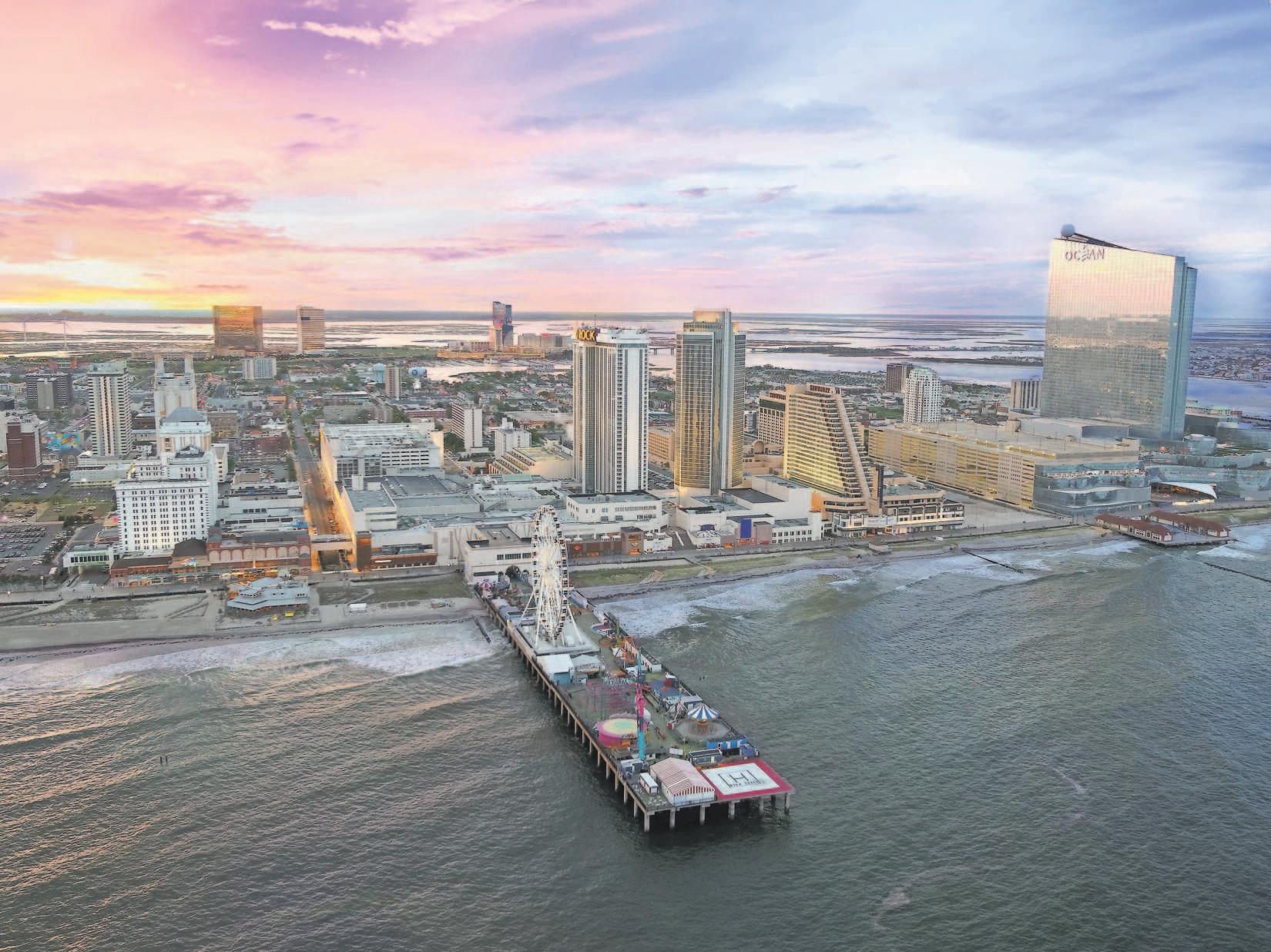
19 minute read
FIND A FLAT
USA TODAY SPECIAL EDITION
By Amy Sinatra Ayres
Advertisement
THE DRAMATIC SPREAD OF the coronavirus has many travelers wondering what to do about trips they’ve already booked, what to consider if they’re planning a new trip and how to stay healthy while getting there.
Heading into the summer months, more states are allowing businesses to reopen with precautions. “Presently, travel in the U.S. appears to be safe, but we need to be smart about our actions,” says Dr. Harry Oken , a practicing internist and clinical professor of medicine at the University of Maryland School of Medicine. “I suspect more people will keep social distancing in mind as they make summer travel plans. I also suspect people will bring with them their own travel kits that include cleaning supplies,” Oken adds.
“If you’re traveling, everyone should wear a face mask and practice decontamination of the mask. An easy way to decontaminate a face mask is to spray it with hydrogen peroxide.”
He recommends travelers “minimize your touches in common areas,” such as airports, train stations or taxis and ride-sharing services. If you’re getting on an airplane, bus or train, Oken says to use an antibacterial wipe to disinfect your seat, the table attached to it, the armrests and headrests — then wash your hands.
“It is still appropriate not to shake hands; use an elbow bump instead. Go the other way when you see people coughing. Try to wash your hands with soap and water often. If it is not available, use an alcohol-based hand gel,” he says.
Making healthy decisions about what you’re eating is also important when you travel, Oken says. He advises selecting “cooked meat instead of uncooked, unless you feel 100 percent confident in the food preparation.” In addition, “Stay away from street vendors. If you do partake, have cooked UP FRONT | ADVICE
The Centers for Disease Control and Prevention recommends following any state and local restrictions if you travel, and quarantining yourself if you come into contact with someone who has the virus .
food. Ask for drinks without ice.”
People who are at a higher risk of severe infection may want to reconsider their travel plans, says Oken. “Advanced age can be a factor, particularly if associated with comorbidities (multiple chronic diseases).” Individuals with underlying immune deficiencies could be at risk, as well as anyone with chronic conditions such as diabetes, lung disease, heart disease and those undergoing chemotherapy or radiation, he says.
The Centers for Disease Control and Prevention says travelers should follow any state and local restrictions and warns that you may be asked to self-quarantine at home if you come in close contact with someone who has the virus.
What if you get sick while you’re traveling? “If you feel like you have a routine cold, follow your routine measures for dealing with the cold. Be sure to cover your mouth when you’re coughing and sneezing and minimize your contact with other people,” Oken says.
If you’re sick, be sure to quarantine yourself, he says. “Typically, I suggest my patients practice ‘watchful waiting’ unless their symptoms worsen over seven to 10 days or are associated with a fever. Be sure you’re getting ample sleep. Sleep is extremely important as it refreshes the immune system. The length of sleep is variable per person, but typically the sweet spot is between six to eight hours.”
Oken, who’s also a medical advisory board member of Persona Nutrition , which provides personalized vitamin subscription services , also emphasizes the importance of good nutrition in general, but specifically for people who aren’t getting at least five servings of fresh fruits and vegetables daily. He advises checking with your doctor before starting any supplement regimen to support overall health and wellness.
UP FRONT | LODGING
Apartment hotels will make you feel at home on the road
By Leila Najafi
FIRST THERE WERE VRBO and Airbnb; now apart-hotels (also called hometels) are getting in on the action. In any case, travelers no longer have to choose solely between a hotel room and a stranger’s house when seeking accomodations on the road.
This hybrid concept — which suggests more apartment than hotel — is designed for travelers who want the warmth of a home with the consistency of a hotel. Apart-hotels are gaining a foothold in the hospitality world with a concept that enables travelers to immerse themselves


in the local culture and still feel like they’re at home when they put their heads down at night.
Here are two apart-hotel options that USA TODAY’s 10Best believes will make you feel right at home during your next visit to Philadelphia or Washington, D.C.:
USA TODAY SPECIAL EDITION
Sonder’s The Heid in Philadelphia
PHOTOS PROVIDED BY SONDER
USA TODAY SPECIAL EDITION

SONDER What started with a college sophomore trying to make side money by temporarily leasing out his apartment has turned into a Silicon Valley startup that has caught the eye of investors seeking to reinvent hospitality. The mission is to create inviting spaces in less touristy neighborhoods while offering the amenities and services of a hotel.
Sonder has a footprint in 36 cities worldwide with carefully curated rooms that draw inspiration from the local UP FRONT | LODGING
neighborhoods. Sonder guests have access to 24/7 support via a mobile app for cleaning requests, concierge help or general assistance with a unit.
The company has units in nine Philadelphia properties, ranging from an average of $74 per night for a studio in the Callowhill neighborhood to $1,600 for a one-bedroom in Old City. There are two locations in Washington and another just across the Potomac River in Alexandria, Va. ▶ sonder.com

Dupont Circle Embassy Inn
Sonder’s Lamont in Washington, D.C.

Communal area at Dupont Circle Embassy Inn
Sonder’s Vine in Philadelphia

FOUND HOTELS FOUND Hotels is aimed at modern travelers who put a premium on shared experiences and meeting new people, offering both private and shared accommodations (i.e., bunk beds), a communal kitchen and social activities at each of its locations. Its goal is to redefine luxury lodging by replacing what it deems the wasteful, outdated model of traditional hotels.
FOUND properties are located in vibrant urban neighborhoods, including the Dupont Circle Embassy Inn in Washington. A bed in a mixed dorm rents for $38.70 per night; a private room with two queen beds averages $108 nightly. ▶ foundhotels.com
Shared room at Dupont Circle Embassy Inn
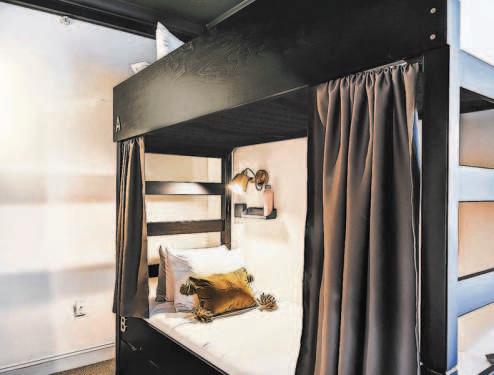
PHOTOS PROVIDED BY FOUND HOTELS
10Best.com is your source for what’s tops in travel, food and culture, providing inspiration to explore the world around you.
Zen in the Time of Coronavirus A restorative retreat could be an ideal way to hit the reset button
By Sarah Sekula HETHER YOU NEED TO block out the noise or break out of a rut, you really can’t go
Wwrong by adding a wellness getaway to your calendar. Even the mere act of planning can spark joy.
Mention wellness travel to 10 people “and six of those people will probably be thinking spa,” says Anne Dimon , president and CEO of the Wellness Tourism Association . “While the sector has, in the minds of many, been long associated with spas, we tend to be moving away from that automatic response. While a massage or other treatments can certainly enhance any form of wellness travel, a spa treatment is not mandatory. Today, the wellness travel big picture is more about food, fitness activities and nature.”
Wellness getaways “are quite necessary for long-term physical and psychological resilience and health,” says Dr. Hans Watson , a Great Falls, Mont.-based neuropsychiatrist and psychotherapist and the founder of mental health practice University Elite . “An appropriate wellness getaway not only provides the psychological recharge we need, but it also gives time for the adrenal glands and neurons to recover and repair themselves.”
Think you might need to restore before you can reset? We’ve rounded up some regional wellnessfocused getaways that can help:
NEMACOLIN WOODLANDS RESORT Farmington, Pa. Situated on 2,000 acres in Pennsylvania’s Laurel Highlands, Nemacolin Woodlands Resort is ideal for wellness-seekers thanks to the expansive Woodlands Spa and the Holistic Healing Center .
Sign up for spiritual workshops, hydrafacials and lessons at the equestrian center. Or try healing therapies at the holistic center that involve virtual reality, energy-balancing crystals and sacred rituals. Be sure to leave time to visit Frank Lloyd Wright’s legendary Fallingwater residence, about 14 miles from the resort. It was named to the UNESCO World Heritage list and also houses an eclectic art collection. ▶ nemacolin.com


USA TODAY SPECIAL EDITION
USA TODAY SPECIAL EDITION
SOJO SPA CLUB Edgewater, N.J. Have you ever soaked in a clay sauna? Strolled along a foot-massage path ? Or tried a Japanese volcanic sand bath ? SoJo Spa Club prides itself on offering these unique wellness treatments from around the world.
Sand bathing gives guests the chance to lounge in mineral-rich volcanic sand, which is said to have detoxifying and anti-inflammatory properties. And red clay is known for its medicinal and cosmetic benefits.
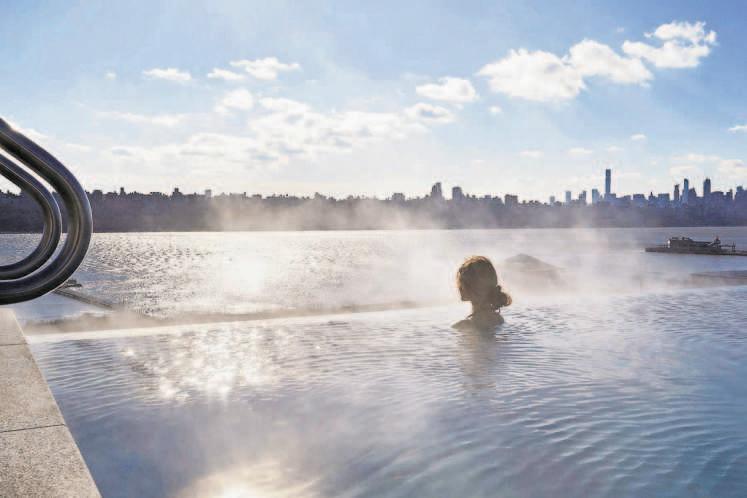
Spend some time unwinding in the hotel’s relaxation lounge on floor mats, beanbags or recliners. And don’t leave without a sauna in a room where the walls are made of salt bricks from the Himalayas that are said to detoxify the body by discharging waste found in the capillary vessels. There’s also a bedrock bathing therapy room where you lie on a heated black mineral slab that emits far-infrared rays and negative ions, believed to speed up the release of toxins. ▶ sojospaclub.com
ADVENTURES ON THE GORGE Lansing, W.Va. “A wellness retreat should be something that recharges your batteries,” Watson says. “This usually means that the activities or destinations involve something you already enjoy.”
While it should be a getaway that reduces your overall adrenaline, he says, brief spurts of it are perfectly fine. A soft-adventure retreat like Adventures on the Gorge should do the trick. The resort, located on the rim of the New River Gorge in southern West Virginia, has a menu of recreation that includes kayaking, rock climbing, whitewater rafting, hiking and

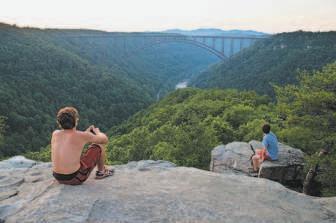
fishing.
After your adventure, you can soak in the hot tub or relax by the campfire. ▶ adventuresonthegorge.com
BELLMOOR INN AND SPA Rehoboth Beach, Del. “For some personalities, wellness activities that involve some adventure and risk-taking is what suits them best,” says Dr. Judy Ho , clinical and forensic neuropsychologist and host of the SuperCharged Life podcast . “For others, they need to decompress and

be on their own in quiet space; for others, wellness actually means more social activities where they are enjoying the company of others without time pressure. There is no one-size-fits-all — it’s more about finding what works for you.”
If a quiet escape is what you’re after, The Bellmoor Inn and Spa is a solid choice. Known for its full-service spa offerings , the R&R choices are overwhelming.
Choose from hydrotherapy, massage treatments, body scrubs and facials that incorporate diamond powder, peptide complex and snow algae to make your skin glow. To keep the Zen mode going, sign up for a yoga session, sound healing, meditation or tai chi. Afterward, cozy up with a novel in the library or take a two-block stroll to the beach. ▶ thebellmoor.com
SOJO SPA CLUB; ADVENTURES ON THE GORGE (2); BELLMOOR INN AND SPA
USA TODAY SPECIAL EDITION




THE IVY HOTEL Baltimore “Self-care practices have been shown to combat burnout symptoms and help alleviate symptoms of depression and anxiety,” says Ho. “In addition, it is a great preventative strategy for both chronic physical and mental illness.”
The Ivy Hotel, a renovated mansion in a historic Baltimore neighborhood, certainly takes self-care seriously. Guests start every day with a made-to-order breakfast featuring freshly squeezed natural juices. Afternoon tea is delivered wherever you might be lounging throughout the hotel. And you can take it easy by piecing together wooden puzzles by the fireplace or playing billiards.

When you’re ready to venture out, SoBotanical , a custom aromatherapy bar stocked with essential oils and body products curated by a certified aromatherapist, is a 10-minute walk from the hotel. PLANTBAR is nearby, too, with plant-based menu items, raw meal plans, juice cleanses and smoothies. Hotel guests can also book an appointment with Thrive Solutions , a mobile IV center that provides hydration infusions to replenish fluids and electrolytes. ▶ theivybaltimore.com

USA TODAY SPECIAL EDITION


EATON WORKSHOP Washington, D.C. Eaton DC combines new-age practices and experiential learning traditions to help guests gain a transformative holistic mind and body connection. Immerse yourself in an assortment of yoga classes and meditation sessions and attend wellness programs throughout your stay.
“In general, people believe wellness is hard to achieve or it takes a lot of effort to do, but research shows that even 30 minutes of self-care a day is amazing for physical and mental benefits,” says Ho. “I suggest that people lean in to their personality preferences for wellness activities. Not everyone is going to love meditation or yoga, but find what works for you.” ▶ eatonworkshop.com/hotel/dc
THE IVY HOTEL (3); EATON DC
USA TODAY SPECIAL EDITION

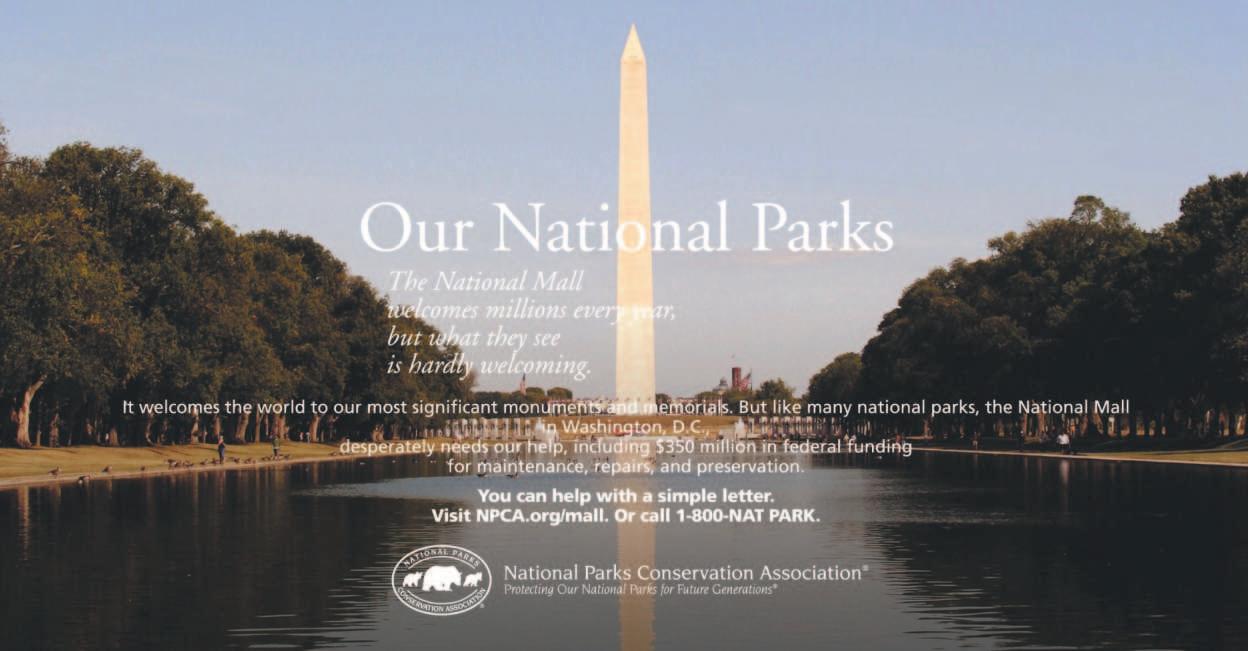
USA TODAY SPECIAL EDITION

1

4 2


3
1. MARINE CORPS MEMORIAL Often referred to as the Iwo Jima memorial, the U.S. Marine Corps War Memorial in Arlington, Va., is dedicated to all Marines who have given their lives in service of the country. The 32-foot bronze figures depict the capture of Mount Suribachi on the island of Iwo Jima in February 1945. nps.gov/gwmp 3. AIR AND SPACE MUSEUM The collection of World War II military aircraft on display at the National Air and Space Museum’s Steven F. Udvar-Hazy Center in Chantilly, Va., includes the Enola Gay, the B-29 Superfortress that dropped the first atomic bomb on Hiroshima, Japan, in August 1945. airandspace.si.edu
2. JAPANESE AMERICAN MEMORIAL At the northeastern end of the National Mall in Washington, D.C., between the U.S. Capitol and Union Station, is the National Japanese American Memorial to Patriotism During World War II . It commemorates the experiences of the more than 120,000 Japanese Americans interned during the war. njamemorial.org 4. ARLINGTON NATIONAL CEMETERY Approximately 400,000 military veterans and dependents are buried at Arlington National Cemetery in Virginia — including President John F. Kennedy , who earned a Navy Marine Corps Medal and a Purple Heart for heroism while helming a patrol torpedo boat in the Pacific during World War II. www.arlingtoncemetery.mil
NATIONAL PARK SERVICE(2); ELIZABETH FRASER; ERIC LONG/SMITHSONIAN INSTITUTION
5

9 6
USA TODAY SPECIAL EDITION

7


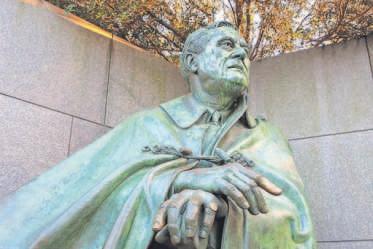
8
5. WWII MEMORIAL Located on the National Mall, the World War II Memorial honors the 16 million members of the U.S. Armed Forces who fought in Europe, North Africa and the Pacific, especially the 405,399 killed during the war. nps.gov/wwii
6. HOLOCAUST MUSEUM One block south of the National Mall and east of the Tidal Basin, the United States Holocaust Memorial Museum’s mission is to serve as a living memorial to the 6 million European Jews killed during World War II and to inspire people to confront hatred, prevent genocide and promote human dignity. ushmm.org
7. EISENHOWER HISTORIC SITE About 90 miles north of Washington in Gettysburg, Pa., the Eisenhower National Historic Site preserves the home of President Dwight D. Eisenhower , Supreme Commander of the Allied Forces in Europe during World War II. nps.gov/eise 8. FDR MEMORIAL A short walk from the World War II Memorial, the Franklin Delano Roosevelt Memorial sits on the Tidal Basin between the Martin Luther King Jr. and Thomas Jefferson memorials. FDR’s four terms in office are chronicled through bronze artwork and quotes carved in stone. nps.gov/frde
9. NATIONAL D-DAY MEMORIAL If your travels take you through southwest Virginia, make a point to visit the National D-Day Memorial in Bedford . Why was this small town chosen for a monument to one of the most pivotal battles of World War II? It’s because it lost 19 native sons on Omaha Beach that day and a total of 23 in the Normandy campaign — proportionally the most of any U.S. community. dday.org
DAN ARANDT; USHMM PHOTO ARCHIVES; NATIONAL PARK SERVICE(2); MARK WILSON/GETTY IMAGES
USA TODAY SPECIAL EDITION
Rosa Parks exhibit shines light on civil rights legend on civil rights legend
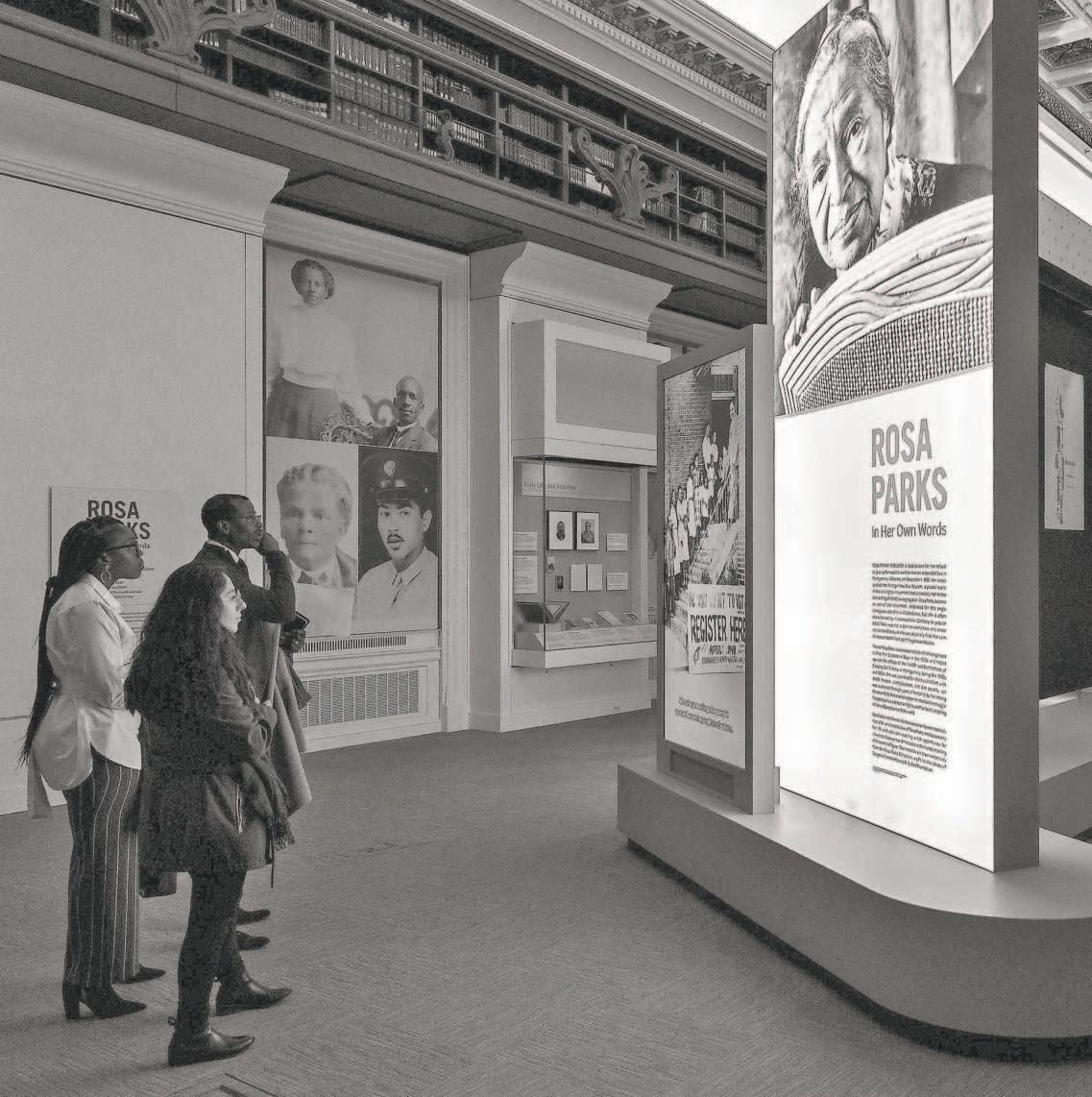






By David Oliver
ou may think you know Rosa
YParks, but a new exhibit aims to further educate visitors about the activist and civil rights icon.
Rosa Parks: In Her Own Words, an exhibition at the Library of Congress in Washington, D.C., reveals Parks was more than the acts of heroism that made her famous. When Parks refused to give up her seat to a white man on a Montgomery, Ala., city bus in 1955, she had already been a champion for equality and justice for decades. Her arrest only provided her with a larger platform to effect change.
“We wanted to get beyond the legend,” says Carla Hayden, the librarian of Congress. “Beyond the tired woman on the bus.”
SHAWN MILLER/LIBRARY OF CONGRESS
USA TODAY SPECIAL EDITION

Family records

Handwritten note
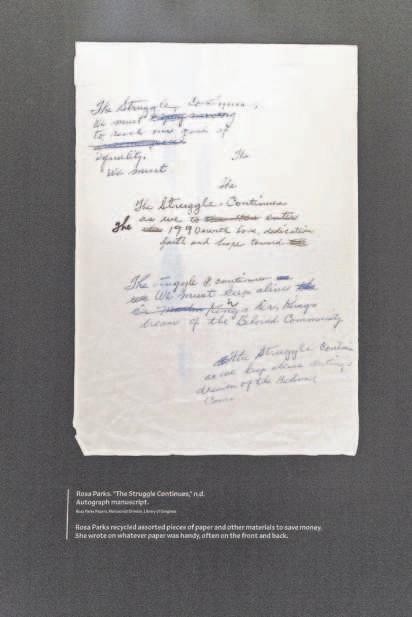
— CARLA HAYDEN, librarian of Congress
Whether you’re looking around or closing your eyes and listening, the pictures, videos, quotes and handwritten letters will immerse you in everything Parks, from her early activism to her support of Jesse Jackson’s presidential campaigns. “It is better to teach or live equality and love ... than to have hatred and prejudice,” reads one of Parks’ quotes.
The Rosa Parks collection includes 140 years of family history and approximately 10,000 items, according to curator Adrienne Cannon. Scheduled to run through September, the exhibition includes everything from Parks’ personal reflections on her arrest to letters, family photographs and a handmade blue dress from her wardrobe. You can even see a sketch of what the bus looked like — and where Parks sat — on that historic day in Montgomery.
The handwritten letters stand out as a compelling feature. Papers showing her impeccable cursive penmanship weave throughout the exhibit, housed in traditional museum glass cases, but also enlarged as posters.
David Mandel, the director of the Center for Exhibits and Interpretation at the Library of Congress, points out how Parks would write things on the front and back of documents, including an envelope and even a pharmacy bag. And that’s part of why they chose to highlight them in the exhibit: “They’re almost art in a way,” Mandel says. “The artistic quality bled over into this humanizing quality that seemed quite poignant.”
Parks’ written words are the most striking feature of the exhibit for Cannon.
“To a large degree, she’s going to bare her soul, and she does that in pencil because it’s tentative,” Cannon says of Parks’ reflections on her arrest. “Because she’s revealing her vulnerability, and she’s not sure what she’s going to say.” Such reflections include her brief incarceration and writing about the larger impact of what living under Jim Crow segregation does to the psyche.
“It simultaneously crystallizes what we know about her, her iconic status as the mother of the modern civil rights movement, the arrest that led to the Montgomery bus boycott … (and it also) presents her as a woman,” Cannon says.
As part of a new pilot program at the Library of Congress, reference librarians will explain how visitors can see and use the materials. Visitors will also be able to go online and download documents for research projects and publications.
Rosa Parks: In Her Own Words is also the title of a book, written by Susan Reyburn, that serves as a companion to the exhibition.
What would Parks think of the exhibit? Fred Gray Sr., her lawyer at the time, thinks Parks would’ve been proud of the progress in today’s world, but that she would strive for more. “I think she would think that all of these honors are good and we’ve made tremendous progress. But I think she would also say that there is still too much racism in this country,” he says. “I think she would tell us she did what she could.”
SHAWN MILLER/LIBRARY OF CONGRESS





